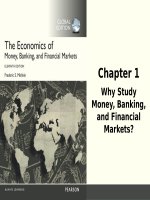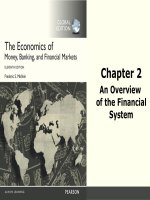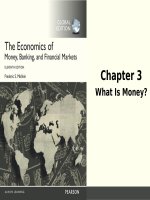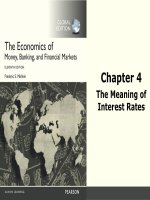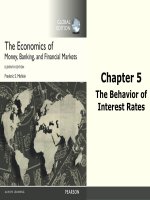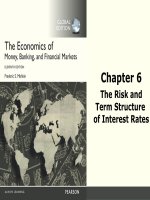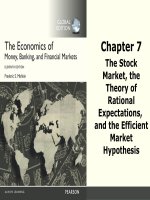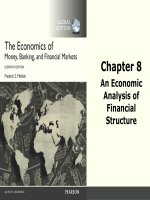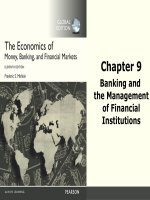The economics of money, banking, and financial institutions (11th edition) by f s mishkin ch7 the stock market,
Bạn đang xem bản rút gọn của tài liệu. Xem và tải ngay bản đầy đủ của tài liệu tại đây (319.77 KB, 23 trang )
Chapter 7
The Stock
Market, the
Theory of
Rational
Expectations,
and the Efficient
Market
Hypothesis
20-1
© 2016 Pearson Education Ltd. All rights reserved.
Preview
• In this chapter we examining the theory of
rational expectations. When this theory is
applied to financial markets, the outcome is
the efficient market hypothesis, which has
some general implications for how markets
in other securities besides stocks operate.
1-2
© 2016 Pearson Education Ltd. All rights reserved.
Learning Objectives
• Calculate the price of common stock.
• Recognize the impact of new information on
stock prices.
• Compare and contrast adaptive and rational
expectations.
• Explain why arbitrage opportunities imply
that the efficient market hypothesis holds.
1-3
© 2016 Pearson Education Ltd. All rights reserved.
Learning Objectives
• Identify and explain the implications of the
efficient market hypothesis for financial
markets.
• Summarize the reasons why behavioral
finance suggestions that the efficient market
hypothesis may not hold.
1-4
© 2016 Pearson Education Ltd. All rights reserved.
Computing the Price of Common
Stock
The One-Period Valuation Model:
P0
Div1
P1
(1 ke ) (1 ke )
P0 = the current price of the stock
Div1 = the dividend paid at the end of year 1
ke = the required return on investment in equity
P1 = the sale price of the stock at the end of the first period
1-5
© 2016 Pearson Education Ltd. All rights reserved.
Computing the Price of Common
Stock
The Generalized Dividend Valuation Model:
The value of stock today is the present value of all future cash flows
Dn
Pn
D1
D2
P0
...
1
2
n
(1 ke ) (1 ke )
(1 ke ) (1 ke ) n
If Pn is far in the future, it will not affect P0
�
D
P0 � t t
t 1 (1 ke )
The price of the stock is determined only by the present value of
the future dividend stream
1-6
© 2016 Pearson Education Ltd. All rights reserved.
Computing the Price of Common
Stock
The Gordon Growth Model:
P0
D0 (1 g)
D1
(ke g) (ke g)
D0 = the most recent dividend paid
g = the expected constant growth rate in dividends
ke = the required return on an investment in equity
Dividends are assumed to continue growing at a constant rate forever
The growth rate is assumed to be less than the required return on equity
1-7
© 2016 Pearson Education Ltd. All rights reserved.
How the Market Sets Stock Prices
• The price is set by the buyer willing to pay
the highest price.
• The market price will be set by the buyer
who can take best advantage of the asset.
• Superior information about an asset can
increase its value by reducing its perceived
risk.
1-8
© 2016 Pearson Education Ltd. All rights reserved.
How the Market Sets Stock Prices
• Information is important for individuals to
value each asset.
• When new information is released about a
firm, expectations and prices change.
• Market participants constantly receive
information and revise their expectations,
so stock prices change frequently.
1-9
© 2016 Pearson Education Ltd. All rights reserved.
Application: The Global Financial
Crisis and the Stock Market
• The financial crisis that started in August
2007 led to one of the worst bear markets
in 50 years.
• Downward revision of growth prospects: ↓g
• Increased uncertainty: ↑ke
• Gordon model predicts a drop in stock
prices.
1-10
© 2016 Pearson Education Ltd. All rights reserved.
The Theory of Rational Expectations
• Adaptive expectations:
– Expectations are formed from past
experience only.
– Changes in expectations will occur slowly
over time as data changes.
– However, people use more than just past
data to form their expectations and
sometimes change their expectations
quickly.
1-11
© 2016 Pearson Education Ltd. All rights reserved.
The Theory of Rational Expectations
• Expectations will be identical to optimal
forecasts using all available information.
• Even though a rational expectation equals the
optimal forecast using all available information,
a prediction based on it may not always be
perfectly accurate.
– It takes too much effort to make their expectation the
best guess possible.
– The best guess will not be accurate because the
predictor is unaware of some relevant information.
1-12
© 2016 Pearson Education Ltd. All rights reserved.
Formal Statement of the Theory
X e X of
X e expectation of the variable that is being forecast
X of = optimal forecast using all available information
1-13
© 2016 Pearson Education Ltd. All rights reserved.
Rationale Behind the Theory
• The incentives for equating expectations
with optimal forecasts are especially strong
in financial markets. In these markets,
people with better forecasts of the future
get rich.
• The application of the theory of rational
expectations to financial markets (where it is
called the efficient market hypothesis or the
theory of efficient capital markets) is thus
particularly useful.
1-14
© 2016 Pearson Education Ltd. All rights reserved.
Implications of the Theory
• If there is a change in the way a variable
moves, the way in which expectations of
the variable are formed will change as well.
– Changes in the conduct of monetary policy (e.g.
target the federal funds rate)
• The forecast errors of expectations will, on
average, be zero and cannot be predicted
ahead of time.
1-15
© 2016 Pearson Education Ltd. All rights reserved.
The Efficient Market Hypothesis: Rational
Expectations in Financial Markets
Recall
The rate of return from holding a security equals the sum of the capital
gain on the security, plus any cash payments divided by the
initial purchase price of the security.
Pt 1 Pt C
R
Pt
R = the rate of return on the security
Pt 1 = price of the security at time t + 1, the end of the holding period
Pt = price of the security at time t , the beginning of the holding period
C = cash payment (coupon or dividend) made during the holding period
1-16
© 2016 Pearson Education Ltd. All rights reserved.
The Efficient Market Hypothesis: Rational
Expectations in Financial Markets
At the beginning of the period, we know Pt and C.
Pt+1 is unknown and we must form an expectation of it.
The expected return then is
e
t 1
P Pt C
R
Pt
e
Expectations of future prices are equal to optimal forecasts using all
currently available information so
Pt e1 Pt of1 R e R of
Supply and Demand analysis states Re will equal the equilibrium
return R*, so Rof = R*
1-17
© 2016 Pearson Education Ltd. All rights reserved.
The Efficient Market Hypothesis: Rational
Expectations in Financial Markets
• Current prices in a financial market will be
set so that the optimal forecast of a securit
y’s return using all available information
equals the security’s equilibrium return.
• In an efficient market, a security’s price
fully reflects all available information.
1-18
© 2016 Pearson Education Ltd. All rights reserved.
Rationale Behind the Hypothesis
R of R* Pt R of
R of R* Pt R of
until
R of R*
In an efficient market, all unexploited profit opportunities will
be eliminated
1-19
© 2016 Pearson Education Ltd. All rights reserved.
How Valuable are Published Reports
by Investment Advisors?
• Information in newspapers and in the
published reports of investment advisers is
readily available to many market
participants and is already reflected in
market prices.
• Acting on this information will not yield
abnormally high returns, on average.
• The empirical evidence for the most part
confirms that recommendations from
investment advisers cannot help us
outperform the general market.
1-20
© 2016 Pearson Education Ltd. All rights reserved.
Efficient Market Prescription for the
Investor
• Recommendations from investment advisors
cannot help us outperform the market.
• A hot tip is probably information already
contained in the price of the stock.
• Stock prices respond to announcements only
when the information is new and
unexpected.
• A “buy and hold” strategy is the most
sensible strategy for the small investor.
1-21
© 2016 Pearson Education Ltd. All rights reserved.
Why the Efficient Market Hypothesis
Does Not Imply that Financial Markets
are Efficient
• Some financial economists believe all prices
are always correct and reflect market
fundamentals (items that have a direct
impact on future income streams of the
securities) and so financial markets are
efficient.
• However, prices in markets like the stock
market are unpredictable- This casts serious
doubt on the stronger view that financial
markets are efficient.
1-22
© 2016 Pearson Education Ltd. All rights reserved.
Behavioral Finance
• The lack of short selling (causing overpriced stocks) may be explained by loss
aversion.
• The large trading volume may be explained
by investor overconfidence.
• Stock market bubbles may be explained by
overconfidence and social contagion.
1-23
© 2016 Pearson Education Ltd. All rights reserved.

